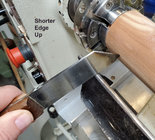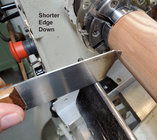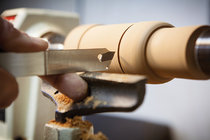-
It's time to cast your vote in the December 2025 Turning Challenge. (click here for details) -
Congratulations to Pat White for "Sicilian Mosaic" being selected as Turning of the Week for December 29, 2025 (click here for details) -
Welcome new registering member. Your username must be your real First and Last name (for example: John Doe). "Screen names" and "handles" are not allowed and your registration will be deleted if you don't use your real name. Also, do not use all caps nor all lower case.
You are using an out of date browser. It may not display this or other websites correctly.
You should upgrade or use an alternative browser.
You should upgrade or use an alternative browser.
Which Way do you hold your Parting Tool ?
- Thread starter Brian Horais
- Start date
I have one of those parting tools but prefer my D-way for a narrow kerf. When I do use it, I use it like the first picture, but I would call that short edge down. It seems like in the second pic, I would have to lower my tool rest to get the cutting (scraping) edge closer to centerline. And it also seems like the "center of gravity" (for lack of a better term) would be "off" I'm not sure that makes a difference, but in my mind it does...
Back when I used one that was ground as your's is I occaisionally noticed that I grabbed it the wrong way - whichever that is. Didn't seem to matter a whole lot in use. For the past several years I've been using the D-Way tapered thin parting tool and only sharpen one angle. That keeps me honest - it still cuts either way, but better with the long edge down...besides since its tapered, there is really only one way it can work efficiently.
Last edited:
Lance Mirrer
AKA "taxman"
Short edge up.
Long edge up, whether it has a second short edge (as in the original post), or only one long edge as with the D-way.
FWIW, on the D-way site there is a link to a video done by Dave where he discusses and demonstrates his parting tool -- he uses it with the long edge up
View: https://www.youtube.com/watch?v=veFLSaBgCQo
FWIW, on the D-way site there is a link to a video done by Dave where he discusses and demonstrates his parting tool -- he uses it with the long edge up
Last edited:
- Joined
- Apr 27, 2004
- Messages
- 9,308
- Likes
- 6,080
- Location
- Lakeland, Florida
- Website
- www.hockenberywoodturning.com
My parting tool is pointed so it doesn't matter. Making one out of an old chef's knife. Will grind to look like the one in hockenbery's photo. I have cheated and used a short piece of hacksaw blade.
Brian Horais
In Memoriam
Thanks for sharing the D-Way video RH. I really shows how well the tool cuts/slicesLong edge up, whether it has a second short edge (as in the original post), or only one long edge as with the D-way.
FWIW, on the D-way site there is a link to a video done by Dave where he discusses and demonstrates his parting tool -- he uses it with the long edge up
View: https://www.youtube.com/watch?v=veFLSaBgCQo
Brian Horais
In Memoriam
Has anyone tried the Easy Woods Parting Tool? It has a 1/8 inch wide carbide cutting bit that can be replaced. The carbide bit cuts very well and the tool is well made but my experience with the tool has resulted in a number of catches as I try to get to too small a diameter before parting the wood with a hand saw. Any other experiences out there?
Attachments
Long edge up.
I have the DWay thin parting tool and use it as they demo in the video. Like your fist picture except there isn't a bevel on the bottom of the tool. I have a few home made ones that are shaped similar to yours but seldom use them. That said, it initially felt counter intuitive to use it this way so I made my handle rectangle shaped to help me hold it straight and curved slightly downward to give it a better feel and remind me which way to hold it. If you watch how he sharpens it in the video it seems any bur would be on back side (bottom when using it) part of the tool so not using the bur to cut. Didn't know a bur was part of the cutting process for a parting tool.
Short edge up.
First picture with the tool rest way closer and the handle way lower to start. I cut in an arc so the handle rises as I near the centerline.
Lance Mirrer
AKA "taxman"
From the answers, I think there are two different references. If we use the OP pics as a guide, long edge means from the handle to the point. Reading descriptions and seeing pics, it looks like those reporting "long edge" up, are referring to the two edges at the end of the tool.
I was surprised that long end up was a viable option, but some of those saying long edge up are showing pic that using the OP pics as a guide, are short edge up.
I was surprised that long end up was a viable option, but some of those saying long edge up are showing pic that using the OP pics as a guide, are short edge up.
My thin parting tool has a flute, and the flute goes up. I do have one of the diamond type parting tools and it has the same bevel on both sides, so no difference with it. I should get a D Way parting tool...
robo hippy
robo hippy
I don't have one, but if I did, I'd hold it with as much support as possible under the tip/cutting edge to reduce the chance of a catch twisting it out of my hand. That would be with the cutting tip at the bottom.
It occurs to me that there are some differences about which short edge we're discussing. I read Brian's origiginal post a few times and came to the conclusion that the edges he points out were the long edges top and bottom of the tool. The short edge then would be different from the shorter of the two ground edges of the tool.
The D-Way parting tool blade is tapered so there is really only one way it can be used.
The D-Way parting tool blade is tapered so there is really only one way it can be used.
I have one that's shown in the OP's pictures, and I also have one with a flute, as Reed mentioned. They're both a very similar shape, and I definitely use them as shown in the first photo!
I hold mine like the first picture- shorter edge up. But my narrow parting tool doesn't have the second bevel on the bottom, like the one in the picture. The bottom edge on mine is straight
- Joined
- Apr 27, 2004
- Messages
- 9,308
- Likes
- 6,080
- Location
- Lakeland, Florida
- Website
- www.hockenberywoodturning.com
That is the way mine came. I was shown to sharpen it at an angle from the bottom.I hold mine like the first picture- shorter edge up. But my narrow parting tool doesn't have the second bevel on the bottom, like the one in the picture. The bottom edge on mine is straight
over time(many years) the short bevel gets too long the I grind the long bevel to bring the short on wher I want it.
Yes, I use the Easy Wood parting tool primarily. While I don't have a lot of hands on experience using other types of parting tools the EW has performed well for me compared to what I've seen others do with their parting tools.Has anyone tried the Easy Woods Parting Tool? It has a 1/8 inch wide carbide cutting bit that can be replaced. The carbide bit cuts very well and the tool is well made but my experience with the tool has resulted in a number of catches as I try to get to too small a diameter before parting the wood with a hand saw. Any other experiences out there?
I'm sure I've had catches, but when parting solid wood I can generally get down to 1/4" to 3/16" before the wood gives way. As with any parting tool I make two overlapping cuts so the kerf is a bit wider than the tool, and I try not to overhang off the tool rest too much. And I definitely make sure the tool is straight up and down.
Hope that helps.
Brian Horais
In Memoriam
Thanks Mark. I do a lot of off-center work, so I find myself extending the parting tool pretty far into the turned item to part it when I put it back on center. That's probably the leading cause of the catches I occasionally incur. The carbide edge on the EW tool does cut a nice groove and I also use two grooves side-by-side to reduce any binding of the tool as the cut gets deeper. The only problem with a catch on the EW tool is that is usually removes the carbide cutter and I have to go into the search mode to find it again and reinstall it.
Just thinking out loud, but I have used the parting tool with the motor off and rotating the lathe spindle by hand when the situation was "fussy". Wouldn't do if there was a lot of wood to remove, but a thought anyway.I do a lot of off-center work, so I find myself extending the parting tool pretty far into the turned item to part it when I put it back on center. That's probably the leading cause of the catches I occasionally incur.
- Joined
- Mar 25, 2008
- Messages
- 313
- Likes
- 302
- Location
- Suwanee, GA
- Website
- www.mikepeacewoodturning.com
I did a video on using a parting tool and was told by one viewer I was holding the thin fluted Sorby parting tool upside down based on their instructions wgich I have attached. I corresponded with Sorby and their "expert" said he did not use this tool but would play with it. A few days later he said he agreed he preferred my approach and would pass on his thoughts up the line. I think it unlikely they will revise their instructions though.
Attachments
Odie
Panning for Montana gold, with Betsy, the mule!
I've been using the fluted Nick Cook parting tool. It works well for me, but I'm using it upside down from the stock photo, so I suppose I'm using it incorrectly, from the perspective of the maker, Sorby.
For my use, the flute goes up.
In my opinion, this parting tool is much more sensitive to a catch, if it's used as shown in the photo.....and, that would be because the distance from the tool rest to the cutting edge is greater.
It might be quite a long time before the ground portion crosses over to the mid point of the tool......I may reverse the tool, at that point.
-----odie-----
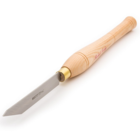
For my use, the flute goes up.
In my opinion, this parting tool is much more sensitive to a catch, if it's used as shown in the photo.....and, that would be because the distance from the tool rest to the cutting edge is greater.
It might be quite a long time before the ground portion crosses over to the mid point of the tool......I may reverse the tool, at that point.
-----odie-----

Brian Horais
In Memoriam
Odie, I like your logic '... the distance from the tool rest to the cutting edge is greater.' This follows my experience for getting a catch with a parting tool. It usually occurs when my cutting tool is extended the most from the tool rest and I am trying to get that final amount removed. I generally finish the parting process with a saw so that I'm not surprised when the parted element takes off. That said, I am guilty of trying to get the diameter of the parting area down to a minimum, at which time the little voice is telling me ' watch out, you are going to get a catch!'I've been using the fluted Nick Cook parting tool. It works well for me, but I'm using it upside down from the stock photo, so I suppose I'm using it incorrectly, from the perspective of the maker, Sorby.
For my use, the flute goes up.
In my opinion, this parting tool is much more sensitive to a catch, if it's used as shown in the photo.....and, that would be because the distance from the tool rest to the cutting edge is greater.
It might be quite a long time before the ground portion crosses over to the mid point of the tool......I may reverse the tool, at that point.
-----odie-----
View attachment 38616
Odie
Panning for Montana gold, with Betsy, the mule!
I think for a great majority of turners, the objective is to get as thin a part as possible on box lids, so that the grain pattern matches as closely as possible.....thus, all the thin parting tools available to us. A thin part gives a more appealing, or aesthetic look in a finished box. For my purposes, I mostly am interested in parting a finished bowl from a waste block. I make the part kerf extra wide, so that the possibility of having a catch is reduced.
I have a couple of the traditional diamond shaped parting tools, and they work, but I've found that a straight sided parting tool with the Nick Cook flute groove gives a cleaner cut with less effort.
I have another parting tool that I only used for a short time. It's straight sided and shaped like this one:
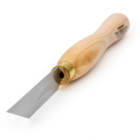
I manually grind spurs into this one, that closely match the cutting efficiency of the the Nick Cook parting tool, however the NC tool is just more convenient for me. (Grinding the spurs manually is something that was introduced to me by Richard Raffan, in his early book, or VHS video tape.)
-----odie-----
I have a couple of the traditional diamond shaped parting tools, and they work, but I've found that a straight sided parting tool with the Nick Cook flute groove gives a cleaner cut with less effort.
I have another parting tool that I only used for a short time. It's straight sided and shaped like this one:

I manually grind spurs into this one, that closely match the cutting efficiency of the the Nick Cook parting tool, however the NC tool is just more convenient for me. (Grinding the spurs manually is something that was introduced to me by Richard Raffan, in his early book, or VHS video tape.)
-----odie-----
I keep thinking about adding the second, short bevel. This narrow parting tool is probably 20-30 years old. It originally had a plastic sleeve for the handle. I finally added wood scales to it for a better grip last year.That is the way mine came. I was shown to sharpen it at an angle from the bottom.
over time(many years) the short bevel gets too long the I grind the long bevel to bring the short on wher I want it.
I don't rush things. lol
john lucas
AAW Forum Expert
Here is my parting tool video. I need to make another one because I have some new techniques that I use.
View: https://www.youtube.com/watch?v=9W2m9JCG6IY&t=17s

